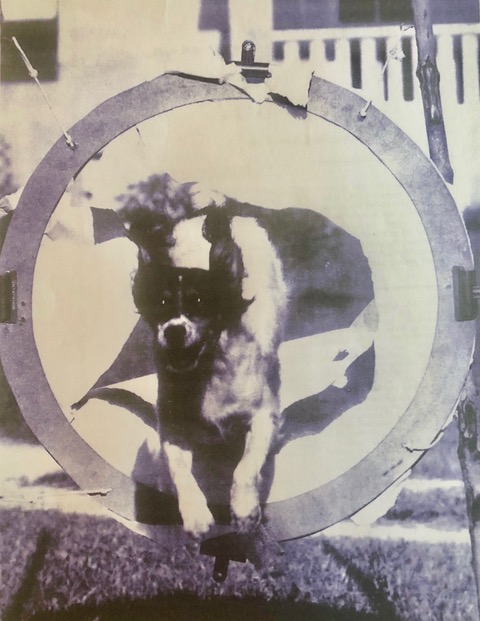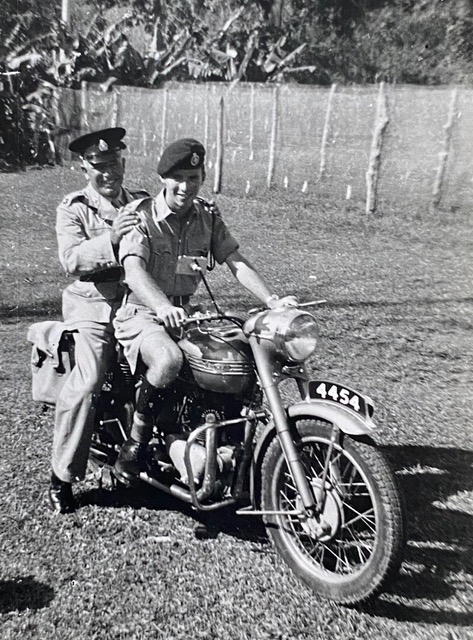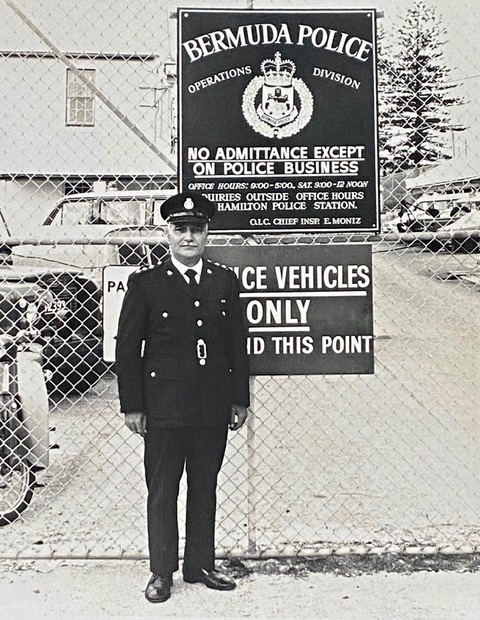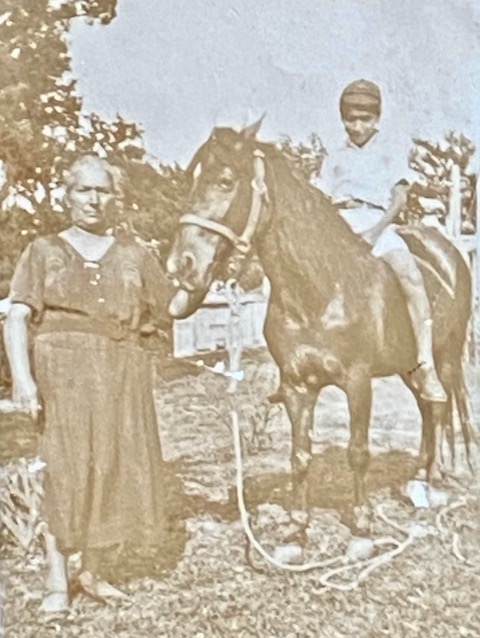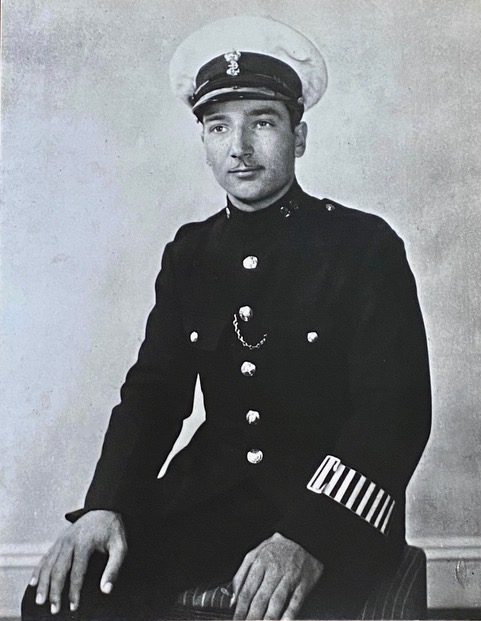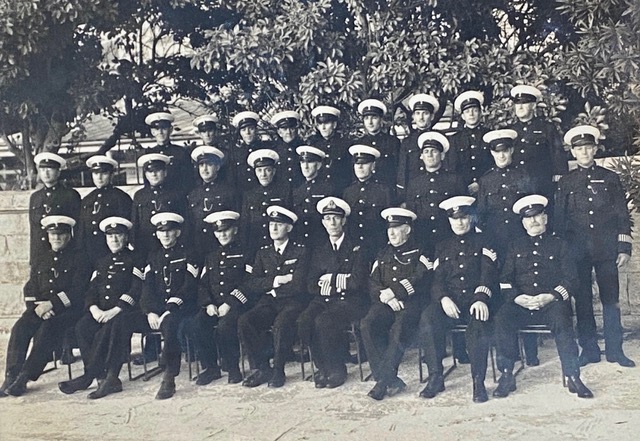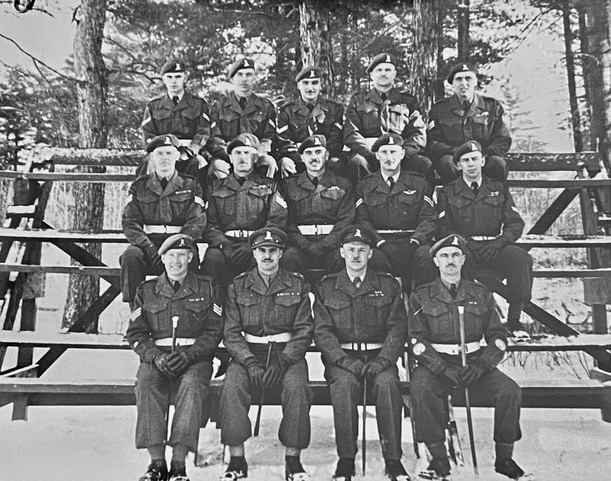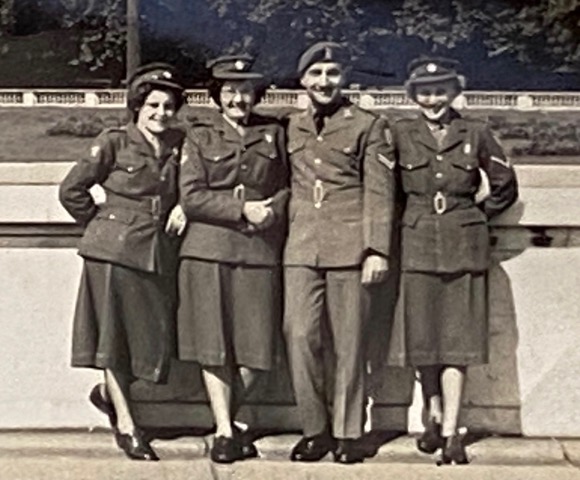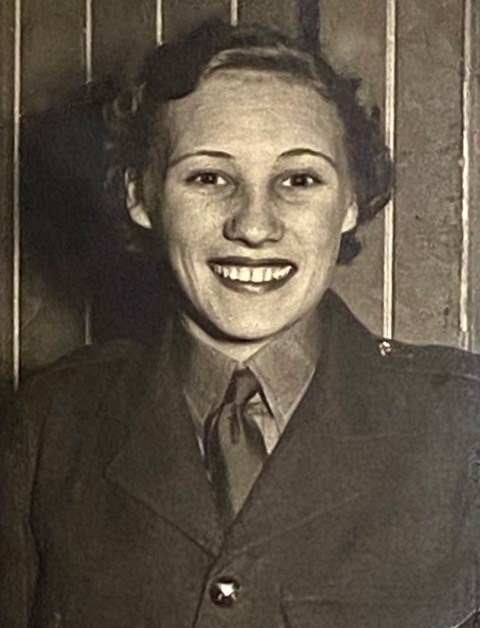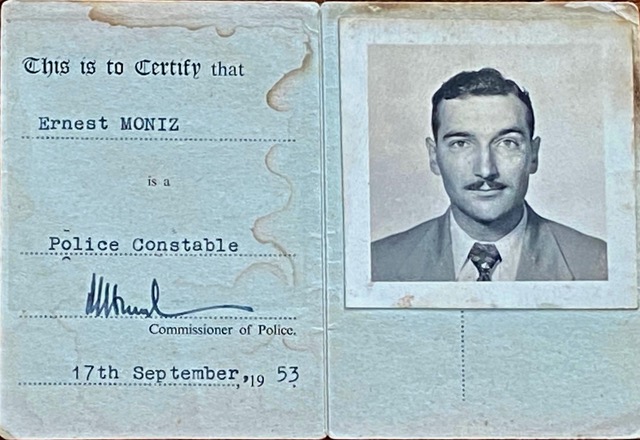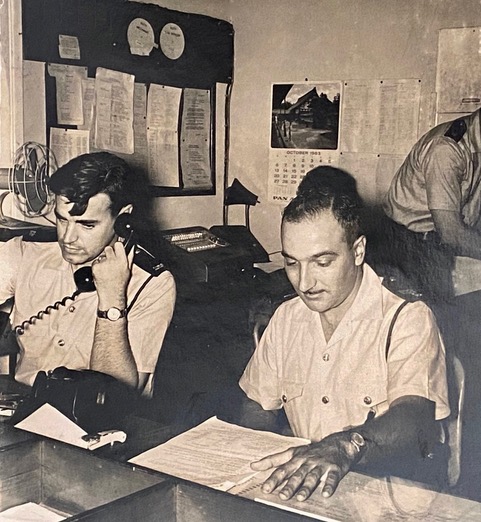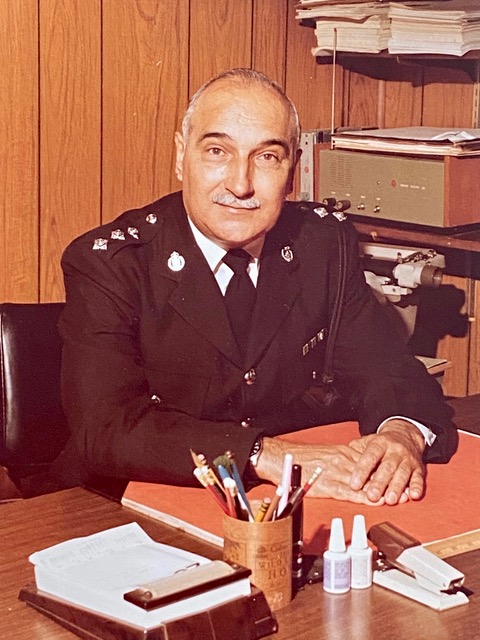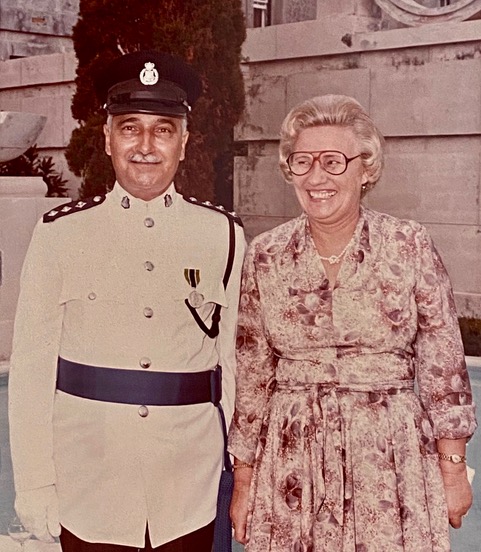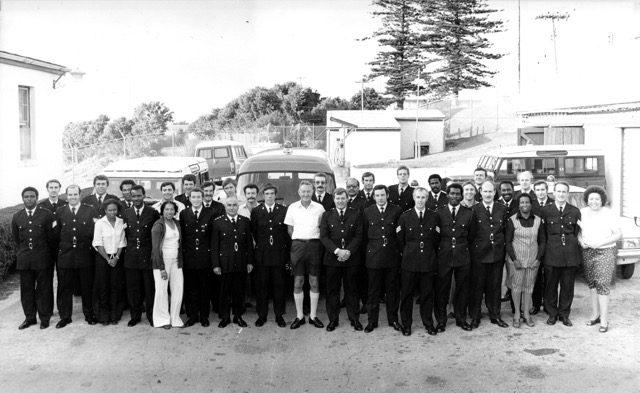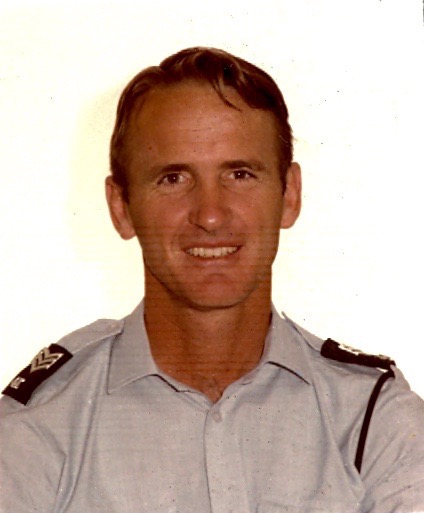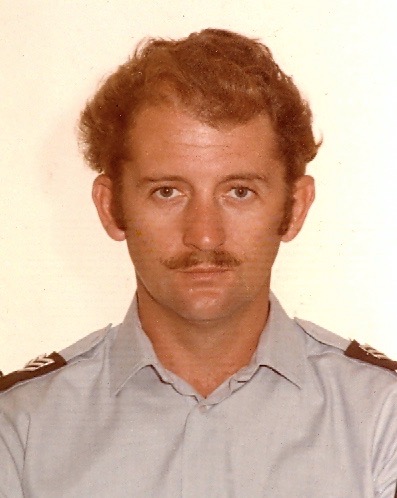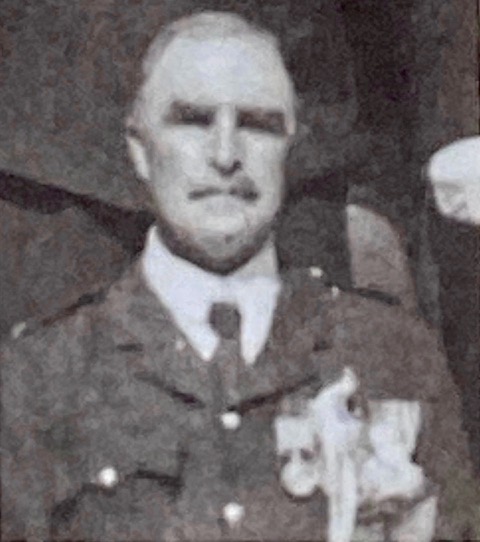Chief of Police Digby R.A. Bettington
Digby Rowland Albemarle Bettington
Chief of Police 1927 - 1933
The Story of one of Bermuda’s Policemen
who served in the Military during
The Boer War and World War One
Researched and written
by
John Skinner, Inspector (retired)
INTRODUCTION
The following article is a continuation of my ongoing project to write about 'BERMUDA'S BRAVE BLUE LINE", that is, about the police officers who have served in the Bermuda Police who also served in the Military during The Boer War, World War One, and in World War Two, whether they did so before or after their Bermuda Police service. This is very much an ongoing project because further research can result in the discovery of new names to add to his list. This is the case with one of our former Chiefs of Police, Digby Rowland Albemarle Bettington, who served in the Bermuda Police from 1927 - 1933.
DEDICATION
This article honours Major Digby Rowland Albemarle Bettington, a member of the Bermuda Police Force who, before coming to Bermuda risked his life in the defence of Great Britain and its Empire. Although a policeman in the Gold Coast Colony (present day Ghana), by the end of World War One he had been appointed to the military rank of Major.
Ashburton is about 53 miles south of Christchurch, New Zealand. The National Library of New Zealand website reports that the Ashburton Guardian newspaper published the following obituary in its afternoon edition on Monday 18th April 1881:
THE LATE CAPTAIN BETTINGTON – We learn from the Broad Arrow (The Naval & Military Gazette) that Captain Claude Bettington C.M.G. formerly of New Zealand died in 29th December of malignant fever, at Elmina, Gold Coast.
Captain Bettington was the second son of Mr. Albemarle Bettington late of the Indian Civil Service. During the New Zealand War, he was a mounted trooper in the A.C. Reserve Force, Poverty Bay. Subsequently he was transferred to the Detective branch of the police force in Canterbury where he was for three years.
He resigned at the end of 1877 and went to South Africa, where he joined the Frontier Force. During the Zulu Campaign, he commanded a small force of mounted irregulars in General Newdigate’s Division. It was by some of the men of Captain Bettington's corps that the late Prince Imperial (the only child of Napoleon III) was escorted on the day when he lost his life.
The deceased officer was present at the battle of Ulundi and received the distinction of CMG for his services during the Zulu War.
His widow, the former Helen Georgina Bertie Falkner of Somerset, England, was aged 36 at the time of Claude Bettington’s premature death. They had married on 17th July 1878 in the parish of East Harptree, Somerset, England. They had a son, Digby Rowland Albemarle Bettington, who was born on 1st July 1880.
Bettington men had been in the service of the British imperial and colonial forces for several generations. They had served in most of the continents where there was a British presence.
In the 1891 English census at Northam, near Bideford, Devon showed that Helen G.B. Bettington, aged 48, born at Bath, a widow, and living on private means, resided in a house called St Ethelberts, together with her son Digby R.A. Bettington, aged 11. He had been born at Pietermaritzburg, Natal, and was a British Subject. A servant lived with them.
Digby R.A. Bettington attended the United Services College in North Devon, England between 1889 and 1897. Young Digby Rowland Albemarle Bettington followed in his fathers footsteps. He joined the Natal Police as Trooper 2105. The Natal Police although a Police unit, was used in the Boer War by the British as an auxiliary mounted military regiment on scouting and VIP security duties. Whilst serving with the Natal Police he earned the South Africa Medal together with clasps showing service in the Orange Free State and the Transvaal,
Bettington transferred to the 1st Kitchener's Fighting Scouts (KFS), another colonial mounted unit on 22nd March 1901. According to a Medal Application roll submitted by Kitchener's Fighting Scouts, Bettington was Corporal 1062 in the unit. On 30th April 1901 as Sergeant 1062, Digby Rowland Bettington, was transferred from 1 KFS to 2 KFS at Pietermaritzburg. He was subsequently promoted to Staff Sergeant Major.
On 31st March 1902, he was dangerously wounded in the abdomen at Boschbult.
The website angloboerwar.com has an excellent article on the Kitchener's Fighting Scouts and the battle at Boschbult. It notes that:
A portion of the 1st KFS were with Colonel Keir‘s column, which, along with Colonel Cookson‘s column, was heavily attacked at Boschbult, 31st March 1902. The detachment of KFS had 1 man killed and 8 wounded.
The website goes on to give its description of the battle:
On 31st March 1902 Major General Kitchener had sent forward two columns, those of Colonel Keir and Colonel Cookson, with the latter of whom were the newly arrived Canadian Mounted Rifles, Damant's Horse, and two squadrons of Yeomanry. At Brak Spruit Colonel Cookson, after being engaged with the enemy, decided to halt, entrench, and close up his baggage.
In his despatch of 8th April 1902 Lord Kitchener said: "At 1.20 pm the enemy opened fire with three guns and a pom-pom, and then under cover of their artillery attempted to rush the eastern side of the camp”. After very heavy fighting the enemy withdrew. Lord Kitchener adds: "The heaviest loss in this engagement fell upon the Canadian Mounted Rifles, who, in this, their first fight of importance since landing, displayed the utmost bravery and determination.
Lieutenant Bruce Carruthers of the regiment especially distinguished himself. Being in command of a detachment of the rear-guard, when coming into camp he remained out in a position of observation, in which he eventually found himself isolated and surrounded by a large body of the enemy. Rejecting all idea of surrender, however, his small patrol of 21 men fought stubbornly on to the end, no less than six of their number, including Lieutenant Carruthers, being killed and 12 wounded. There have been few finer instances of heroism in the whole course of the campaign. The Boers who took part in this unsuccessful attack upon Colonel Cookson's camp were estimated to have numbered 1800 men, and were under the command of Generals Delarey and Kemp".
The website also noted that amongst the ‘Mentions in Dispatches’ awarded to members of the Regiment were the following:
1st June 1902 - 2nd KFS — Lieutenant J S Kelly, Sergeant Major D R Bettington, Farrier Sergeant W Welsh, Sergeant E Hatison, Trooper De Wet, for good service in action at Boschbult, 31st March 1902.
After the Boer War, Digby R.A. Bettington joined the British colonial police service. The Cyprus Blue Book 1903 to 1904 shows that on 9th February 1903 he was appointed an Inspector of Police. After service in Cyprus, he moved to Sierra Leone.
The website irishconstabulary.com, which records the history of the Royal Irish Constabulary reports that the Irish Times of October 12, 1907 showed that Digby Bettington was a member of the Sierra Leone Police in 1907 and that he was one of seven Colonial Police Officers who joined the R.I.C. Depot for a course of training.
Bettington was appointed Deputy Commissioner of Police, Gold Coast (present day Ghana), in 1910.
On the 10th September 1912 at Wolvercote near Oxford, Oxfordshire, England, Digby Bettington’s cousin Lieutenant Claude Bettington, 30, and Second Lieutenant Edward Hotchkiss, Chief Test Pilot for the Bristol Aircraft Company were flying a Bristol Coanda Military Monoplane when it malfunctioned and crashed killing them both. The Air Accident Report indicated that a quick-release catch holding a strap opened and the strap broke a flying wire which whipped about, tearing a hole in the starboard wing. Fabric stripped off and control became impossible and the aircraft crashed. One report indicated that this was the third fatal accident of the newly formed Royal Flying Corps. This accident was also mentioned briefly in the Royal Gazette of October 5th, 1912.
Digby Bettington wrote an article which was included in the publication ‘From Our Days On The Gold Coast In Ashanti, In The Northern Territories, and The British Sphere of Occupation In Togoland’ edited by Lady Clifford, G.B.E. (wife of the Governor of Gold Coast Colony when World War 1 was declared). This publication was produced in aid of the Red Cross, 1918 London by John Murray, Albemarle Street, W, in 1919.
A POLICEMAN'S DAY - A week after the Great War had begun, we in Accra heard from the Officer Commanding Troops, Coomassie, that a detachment of police would be wanted to go to Togoland with the column. I got my chief to let me go in charge of them, and we got the approval of the Accra Officer Commanding Troops and the Acting Governor.
I was delighted, and rushed off to tell my wife, and she was not going to be out of anything, so off she went to the Principal Medical Officer, and arranged that she should go if the Officer Commanding Column agreed. (She had volunteered for Red Cross work the day war was declared, being a trained nurse).
The Bedfordshire Mercury reported on 12th April 1907 that “ Mr Rowland Albemarle Bettington married Alice Maud Mary , widow of the late Mr Franklin Hurst, Deputy Chief Resident Engineer on the Gold Coast” on 6th April 1907 at “St. Georges Cathedral, Freetown, Sierra Leone by Rev. Canon F.C. Smith”.
According to a legal notice in the London Evening Standard 28th April 1904 Franklin Hurst late of Sekundi, West Africa died at the Westminster Palace Hotel, London on 23rd January 1904. His cause of death was not given.
Alice Hurst was a Nursing Sister. She is recorded as Alice Williams by the British Nursing Association as working at the Government Hospital, Accra, West Africa from 1897. She had gained her qualifications and also worked at Charing Cross Hospital. She later became a District Nurse and subsequently a private nurse before moving to Accra. I have not found any record that they had any children.
 Extract from British Nurses Association
Extract from British Nurses Association Register 1898 Alice Maud Mary Williams
(Source ancestry.com)
A Policeman's Day article continued:
It was a very busy day selecting the men who were to go, and getting them fitted out with kit, etc.; of course, they all wanted to go, and it went to one's heart to refuse them all, but it could not be helped. It made me have a lump in my throat with joy and pride at their keenness.
The Officer Commanding Column landed, and we received orders to be on board the transport at 5 p.m., and I heard my wife was to follow in a day or so, so that was all right. The police detachment paraded later on at Ussher Fort, and off they marched to the beach. The men who were left behind showed up good sportsmen, and crowded out helter skelter into the street and gave the detachment a splendid send-off, cheering again and again. The public, of course, quickly crowded up, and when they found out what it was, joined in the cheering. It was “ripping”. We all piled into surf-boats that were waiting, and embarked on the transport, and when we sailed away, soon after, to do our bit, what-ever it was going to be, the sun set on the day of days of my time on the Gold Coast.
Harry Fecitte’s website ‘Harry's Africa Web’ gives an interesting account of the British invasion of Togoland. I have only included a small part of that extensive entry here:
Togoland Invasion
The Anglo-French invasion
Introduction
In August 1914 Germany held four territories in Africa - German East Africa, German South West Africa and the Cameroons were large but the fourth territory, Togoland, was a small oblong-shaped possession on the Gulf of Guinea that had the approximate land mass of Ireland. Its width averaged 120 miles and its length 300 miles.
To the west of Togoland lay the British Gold Coast, to the east lay French Dahomey and to the north was French Upper Senegal & Niger.
By effective management the Germans had made Togoland into a successful colony that paid all its own costs. Three short railway lines had been laid from the capital and the chief port of Lome going northwest, east and north. The northern line terminated just past Kamina, approximately 110 miles from Lome.
At Kamina the construction of a high-power nine-mast wireless station had just been completed in July 1914. In the words of the Governor of the Gold Coast, Sir Hugh Clifford, this station was: “destined to be the pivotal point of the German world-wide wireless system . . . designed to communicate with Berlin on the one hand, with Windhoek in German South West Africa, and with Dar Es Salaam on the east coast with the other”. The station could also communicate easily with the Cameroons and with German ships in the Atlantic Ocean.
In Togoland there were no German army units but there were believed to be 800 armed police and 200 or more German civilians who had received some military training. The Governor of Togoland, Duke Adolf Friedrich zu Mecklenburg was on leave in Germany the military commander and acting governor was Major von Doering. August 1914 in the Gold Coast was also holiday season and both the Governor and the Commandant of the Gold Coast Regiment (GCR), Lieutenant Colonel R.A. de B. Rose, were enjoying leave in the United Kingdom.
Mr. W.C.F. Robertson was the acting Governor and Captain F.C. Bryant, Royal Artillery, was the acting Commandant. The GCR was part of the West African Frontier Force (WAFF). The GCR was organized into one pioneer company; seven infantry companies each with one machine gun and one artillery battery of four 2.95 inch guns.
Also of military use in the Gold Coast were the 320 men of the Northern Territories Constabulary armed with carbines, three machine guns and a 7-pounder gun, plus 800 civil police and 400 men of the Customs Preventive Service, all semi-militarily trained and mostly armed with carbines. These three non-GCR units played useful roles in the forthcoming operations.
On receipt of orders from London Captain Bryant immediately started deploying the GCR and mobilizing its reservists in accordance with the Territory Defence Plan that envisaged attacks upon the Gold Coast by German troops from Togoland. Meanwhile in London the Inspector-General of the WAFF, Brigadier General C.M. Dobell, as a member of the interestingly-titled Offensive Sub-Committee of the Committee of Imperial Defence, submitted a proposal accepted by the Sub-Committee stating that the GCR should immediately invade Togoland, capture Lome and advance north to capture Kamina.
On the ground Bryant was of a similar opinion and was making the necessary plans. At this stage the British were working on the assumption that French troops would not be involved in any operations in Togoland.
On 5th August 1914 the British and the French received a telegram from Major von Doering requesting that the colonial territories remain neutral, and not involve themselves in the European war. This was viewed as an enemy ploy to keep the Kamina wireless station operating, and was disregarded.
The following day and acting purely on his own initiative, Bryant sent his company commander at Ada, Captain E. Barker, overland under a flag-of-truce to Lome with an ultimatum that von Doering surrender his colony. A reply was to be made within 24 hours during which neither side would move troops towards the frontier.
British wireless intercepts now learned that von Doering intended to evacuate Lome and move north to defend Kamina. London, trying hard to catch up with Bryant's initiative, ordered that if Lome was surrendered it must be immediately occupied as a base for an advance on Kamina.
Barker started his troops marching eastwards on the coast towards Togoland on 7th August and returned ahead of them in a lorry to Lome for the German answer. He found von Doering and his troops gone. The local District Commissioner, Mr. Clausnitzer, surrendered Lome and around a hundred German civilians to Barker.
The next morning a Gold Coast telegraph operator arrived at Lome on a bicycle, with an instrument and appropriate spares, allowing him to repair the disabled German telegraph facility and establish communications with the Gold Coast.
Back in Accra the British had heard from London that the French had agreed to cooperate and were moving regular troops into southern Togoland from Dahomey to the east, whilst irregular mounted troops were moving into the German colony from the north. Barker's soldiers force-marched across the border to Lome on 9th August, followed by other GCR companies, and a group of Gold Coast officials arrived by sea from Accra and set about restoring sanitation, communications and port facilities in the capital and providing medical services for the troops.
(When Sir Hugh Clifford returned to Accra to resume his Governorship he found considerable disarray within the Gold Coast administration because of the absence in Togoland of his key officials.)
Bryant was made a local Lieutenant Colonel and appointed allied commander. By 12th August he was established in Lome with a force of over 550 officers, British Non Commissioned Officers (NCOs) and men of the GCR, three 2.95 inch guns, four machine guns, 50 Gold Coast police, 34 Gold Coast civil officials and volunteers and 2,000 carriers and labourers. The Germans were demolishing railway bridges on the Kamina line and so the British immediately advanced north along a rough road that ran alongside the railway, supported by civilian railway construction crews from the Gold Coast who repaired the line.
Raiding parties totalling 200 men in two trains were sent south by von Doering on 15th August 1914 to disrupt the British advance, but the GCR managed to block the line to the north, trapping the trains and the troops in them. One train of 20 carriages was derailed at Ekuni by obstacles placed on the line by Lieutenant H.S. Collins and his men, and the second train was captured by Captain H.B. Potter at Agbeluvoe after fierce fighting.
Six enemy Europeans were killed including the German commander Captain Pfaeler and 16 were captured. British casualties in these actions and in skirmishes involving Bryant’s main column to the south totalled 7 killed and 38 wounded, 30 of the wounded being carriers. Several of the wounds inflicted on British personnel were very destructive, signalling that many Germans were using soft-nosed hunting ammunition. Von Doering later acknowledged this but disclaimed personal responsibility.
Meanwhile in the north of Togoland British and French troops, constabulary and irregulars had occupied Yendi and Sansanne Mangu respectively. Further south a GCR detachment occupied Kete Krachi and French troops occupied German posts on and near the Dahomey border. On 17th August Bryant’s force was reinforced by Captain Castaing and his 150 Tirailleurs Senegalaise (French colonial infantry) with seven French officers and NCOs. Two days later a large column of 345 Senegalese soldiers and 23 French whites left Tchetti at Bryant’s request to advance on Kamina from the east. From the west the “Krachi Column” of three GCR companies moved from Kete Krachi towards Kamina. Von Doering was being threatened on all sides. But the better German troops maintained a good fighting spirit and their commander chose a battlefield that lay across Bryant’s route.
After resting his men and obtaining a re-supply of ammunition and rations that were transported forward from the railhead on the heads of the carriers, Bryant advanced again. The Gold Coast Assistant Commissioner of Police, Captain A.F. Redfern, was commanding patrols ahead of the main column and on 21st August his men found the railway bridge 500 yards south of Chra village to be demolished. As the patrols moved towards the village two mines were exploded in their path and two German machine guns opened fire. The scouts continued probing until they established that a strong German entrenched position was located in the village which lay on a rise in the ground. Here the road passed through the west of the village whilst the railway used a cutting on the east side. Dense bush encroached on both flanks which were covered by three German machine guns. Von Doering had placed over 40 German whites and around 300 Togolese soldiers at Chra (more arrived during the fighting).
Bryant attacked on the following day with two columns and an advance screen of scouts, Bryant’s left and right flanking parties disappeared into the thick bush and out of his sight and control. Messages had to be sent with runners who made good targets for enemy marksmen. The Allied troops in the bush could not observe more than a few feet forward and this prevented platoons from supporting each other’s movement with aimed fire.
The tactical initiative was held by the Germans who had spent three days preparing their defensive positions and fields of fire, and whose re-supply was delivered by train from Kamina. Bryant’s men were attacking with whatever carrier loads of ammunition accompanied his column.
At around 1530 hours Lieutenant Thompson judged that the enemy fire had slackened sufficiently for an assault to be practical, and he charged the enemy trenches with his men. However the German defenders had just been reinforced by a company that arrived by train from Kamina, and they shot the assaulting Allied troops down at 50 yards range. Lieutenant Thompson, Lieutenant Guillemart of the French Colonial Infantry, one GCR sergeant and 12 Senegalese soldiers were killed and many more were wounded. The surviving men entrenched themselves east of the railway cutting.
Bryant planned a new attack on Chra to be mounted at first light on the next day. This time he intended to attack only on the west flank. But Allied patrols found that the enemy had withdrawn during the night.
Bryant's men spent the next 48 hours at Chra evacuating wounded by an improvised ambulance train that was not far behind the column, thanks to the rapid repairs made by the railway engineers, and preparing for a further advance.
On the night of 24th August the Allies heard loud explosions from the direction of Kamina and on the following morning patrols failed to see the masts of the wireless station.
On 27th August both Bryant's column and the French one from the east entered Kamina and found all the nine huge wireless masts demolished and everything that was breakable broken. Fuel oil had been poured over mechanical and electrical items and ignited. Over 200 Germans surrendered with three machine guns, more than 1,000 rifles and 320,000 rounds of ammunition. The German Togolese troops had no doubt disappeared into the countryside. German resistance in Togoland ended and the first Allied victory of the Great War was proclaimed.
George Masterman Thompson was the first British officer to be killed in action in the Great War. A Special French Army Order was published on 20th October 1914 commending his gallantry and the fine example he gave to the French soldiers temporarily under his command. He was awarded the French Croix de Guerre with
Palme. His is the only British grave in the small Wahala Cemetery near Atakpame, Togo.
Sergeant Asuri Moshi, Gold Coast Regiment, who fell at his side, is commemorated on the Kumasi Memorial, Ghana along with the other Gold Coast Regiment soldiers killed in Togoland.
An official medal document for the 1914-15 Star for members of the Gold Coast Police, including an entry for Deputy Commissioner and Captain D.R.A. Bettington and states that their Date of Embarkation was 12th August 1914.
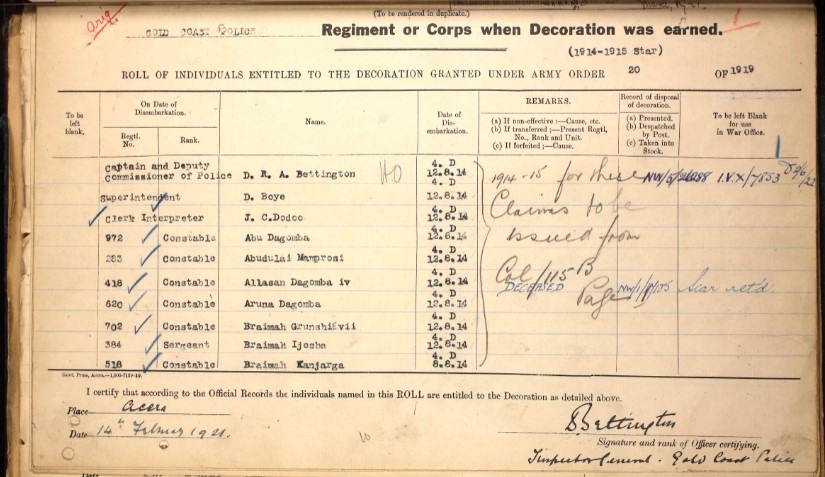 Gold Coast Police 1914-15 Star Medal Roll
Gold Coast Police 1914-15 Star Medal Roll signed D. Bettington 14th February 1921
(© National Archives)
Mr. E. V. Collins was Inspector General, Gold Coast Police, when he was killed on the ss Abosso, which was sunk by the submarine U-43 on 24th April 1917 whilst it was on its way to UK. (See Wikipedia). As a result Digby Bettington was appointed to the post of Inspector General of the Gold Coast Police and Prisons. (Colonial Report – Gold Coast 1919).
Another official Record of the Medal entitlements of the Gold Coast Police records that Deputy Commissioner and Captain D.R.A. Bettington was entitled to the Victory Medal and the British War Medal for service in Togoland. This document is also signed D. Bettington, Inspector General, Gold Coast Police.
An official Medal Index card tells us that D.R.A. Bettington, a Captain of the Gold Coast Police was entitled to the Victory Medal and the 1915 Star.
It appears that during World War One senior Police Officers in certain British colonial police forces held a simultaneous military rank together with their police rank. The practice of using the police as an auxiliary military unit appears to have continued when the need arose. Deputy Police Commissioners held the army rank of Captain and Commissioners/Inspector Generals the rank of Major.
Although at war, there was sometimes an opportunity to take part in the lighter side of life as the following photograph and its caption illustrates.
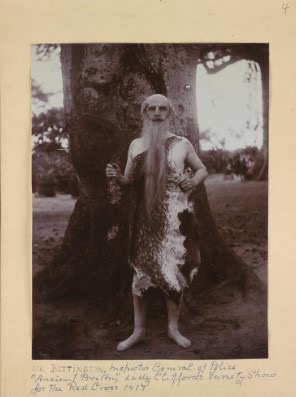
The handwritten caption reads:-
‘Mr Bettington, Inspector General of Police “Ancient Briton”.
Lesley Clifford’s Variety Show for the Red Cross 1917
(Source the Smyly collection University of Cambridge).
In a transcript of the 1919 Kings Birthday Honours List we are advised that Maud Bettington was awarded an MBE, for services in connection with hospital work on the Gold Coast. The Gold Coast Blue Book of 1919 confirmed that Maud Bettington was in fact Mrs. D.R.A. Bettington.
The Supplement to the London Gazette of 1st January 1920, in a list of appointments for ‘Dominions Beyond the Seas’ announced the award of the Kings Police Medal to Digby Rowland Albemarle Bettington, Inspector-General of Police, Gold Coast Colony.
Digby Rowland Albemarle Bettington left the Gold Coast Police in 1924 and became Commissioner of Police in Bermuda on 20th July 1927. The only documented clue I have found as to where he went in the intervening years comes from a passenger manifest of the ss Coronado. This ship left Liverpool on 26th November 1924 bound for Kingston, Jamaica followed by Port Limon, Puerto Rico and then Panama.
Digby Rowland Albemarle Bettington and Alice Maud Mary Bettington were travelling first class to Kingston. His occupation was listed as ‘Commandant of Police’ and his ‘Country of future intended Residence’ was given as ‘Bahamas’. I have been unable to find contemporaneous documents corroborating the record of his service in Bahamas.
The Royal Gazette of 18th July 1927 announced to Bermuda the new Chief of Police.
New Chief of Police.
Although no official information is available on the subject, we understand that the new Chief of Police is Mr. Digby Rowland A. Bettington. We suggested sometime ago that the appointment had been made, but on application to official quarters, all knowledge of the new Chief was denied. Mr. Bettington is due to arrive next Wednesday.
The new Chief of Police quickly had an official function to perform as reported by the Royal Gazette on 23rd July 1927:
The Assembly made their first acquaintance with the new Chief of Police, Mr. Digby Bettington, who as the “Black Rod" has the duty of summoning the members to attend the Acting Governor at the Council Chamber. He carried out the duty very well indeed, due no doubt to the dress rehearsal with the Sergeant-at-Arms the day before!
Two days later the Royal Gazette reported that an old friend had arrived in the Colony
Mr. Lorimer Hammond also from New York will be here for some time, and Captain J. Fuller of New York, representing the Associated Press and who has many wonderful schemes for the future of Bermuda, are other guests at the American House. Capt. Fuller has seen much service in his time and is delighted to renew his acquaintance with Mr. Digby Bettington, Chief of Police, who is also a guest at the American House. They met before in South Africa.
The following month Mrs Bettington was scheduled to arrive as reported by the Royal Gazette on 2nd August:
Personal.
Mrs. Digby Bettington, wife of the Chief of Police, will leave England on Thursday to join her husband in Bermuda. She travels by the ss Orbita.
Mrs. Bettington is another “veteran” of the Great War, for she saw service with the Togoland Field Force, as a nurse, in which her husband also served, and wears 1914-1915 Star, Victory and War Medals. For other services, further similar services, on the Gold Coast, after the conclusion of the war, Mrs. Bettington was awarded the M.B.E.
A Medal Application Roll for the 1914-15 Star for a number of civilians who accompanied the Togoland Field Force, and most including Mrs Bettington’s had a notation against their names. The notation signed ‘R.E. Field’ read ‘Not entitled, but as issued not to be recalled’.
In the New Year the Bettington’s had a personal disaster as reported by the Royal Gazette on 27th January
Regrettable Fire.
CHIEF OF POLICE LOSES VALUABLE BELONGINGS.
Collection of Many Years of Travel Totally Destroyed.
Early yesterday morning, a fire broke out in the stables adjoining the house occupied by Mr. Bettington, Chief of Police, and before help could arrive the place was completely gutted, and the contents destroyed.
This is all the more regrettable because a number of trunks containing personal belongings, and a collection of valuable antiques and curios, acquired by him on his travels during his long service in foreign countries were stored in the stables. These highly prized possessions were all destroyed, and much sympathy is felt for Mr. and Mrs. Bettington for their severe and personal loss.
No clue to the origin of the fire is yet obtainable, but it is believed to be accidental.
Later an inquest was held into the fire which returned an ‘Open Verdict’.
The Royal Gazette of 18th October 1927 reported a test case which Mr Bettington prosecuted.
A Test Case:
The test case was brought personally by Mr. D.R.A. Bettington, Chief of Police, who charged Rudolf Swan, coloured, with leaving his horse and truck untied and unattended in Victoria Street on the 14th inst. A plea of guilty was entered.
Mr. Bettington, in describing this particular case, called the court’s attention to the fact, that while the Corporation of Hamilton had passed this regulation there was nothing done by them in the way of providing rings in the sidewalks, or hitching posts to which horses could be tied, and in his opinion he did not think that poles of the Electric Light and Telephone Companies were the correct things to use.
Neither did he think it just that two persons should be employed on a trolley or wagon, one to hold the horse while the other made the deliveries, etc. Nevertheless the law was there and there is nothing else for the Police to do but enforce it. It was found that defendant had a previous conviction for the same offence for which he had been fined £1. In this instance, the Magistrate fined him 2/6d.
In order to understand some of the monetary values mentioned, it is useful to know that until 1970 Bermuda had the same currency as the UK namely Pounds, Shillings and Pence. Pounds were indicated with the ‘£’ sign, shillings with an ‘s’ and pence using ‘d’. The ‘d’ is believed to be a legacy from the Roman invasion of Britain when they used denarius. Ten pounds, three shillings and 5 pence would be described as £10.3.5d. A sum of less than a pound such as the fine written in the article above as 2/6d indicated two shillings and six pence.
An article in the Royal Gazette of 28th October 1927 gives an insight into some of the cost of running the Bermuda Police Force.
No. 390/27.
Police Headquarters,
Hamilton, Bermuda.
30th August, 1927.
From the Chief of Police
To the Honourable The Acting Colonial Secretary.
Reference to my remarks on item Telephones in paragraph 4 of my memo No. 353/27 of the 5th instant, which read as follows:—
Telephones.
Increase of £40. To provide for additional number of rentals due to the following members of the Force being on the telephone:—-
Sub-Inspector,
Detective Officer,
4 Sergeants.
1 District Area Constable.
Under the existing housing conditions it is essential that these members of the Force should be on the telephone.
The question of installation of 4 of these telephones is forming the subject matter of a separate communication to be dealt with under the current financial year. I have now obtained the particulars required with regard to the installation and rents to be charged to the current year’s estimates, also for an additional telephone improvement at Headquarters.
Funds are not available, and a Supplementary Appropriation of £35 is applied for.
2. The installation of the 4 telephones will cost £12.15.0. Extension at St. George's Police Station to the Sergeant’s office, and table telephone for the Sergeant, will cost £1.10.0. Total £14.5.0.
3. Now as regards Headquarters, the present telephone system is not convenient.
Present System:—-
1 line in charge room.
1 line upstairs in Registration Office, with
1 Extension table telephone with bell buzzer to my office, and
1 Extension wall telephone, with no buzzer, to Inspector’s Office.
The Superintendent has no telephone in his office, nor has the Sub-Inspector in his.
At present if the Superintendent is rung up or wants to telephone he has to leave his office and come to the nearest telephone in the Registration Office. This takes him away from his desk and work; is not expeditious or convenient. The Inspector has to get up and go to the wall telephone. The Sub-Inspector has none at all, and as he is my Chief Clerk (vide amended Police Regulations) it is obviously most inconvenient and time is wasted.
4. After consultation with the Manager of the Telephone Company, the following improvement is proposed which will make for efficiency.
Proposed System:-—
A small switchboard to be installed in the Police Charge room. Two trunk lines to go through this board. Table telephones to be installed for: The Superintendent, Inspector, Sub-Inspector, and Registration Clerk, at a cost of 10/- each…£2.
Each Officer can then get through or be got at quickly, and each Officer can speak to each other on the telephone if required; more time saved. The cost of installing the switch board is £5.
5. The rentals from the 1st October for the balance of the current year, and the installation in Paragraph 2 above, will be £7, and the increased rental for the switchboard will be £6 for the same period.
6. Summary.
(a) Extra installations, Hamilton and St. George's......................................£14
b) Installation of switch board at Headquarters………………………………………. £5
c) Installation of 4 table telephones at Headquarters ................................ £2
d) Rentals 1st October to 31st December, 1927, for (a) .............................£7
e) Rentals 1st October to 31st December 1927, for b)……………………………..£6
Total £35
Extras £15
7. For 1928 an extra £19 will be required in addition to the increase £40, already applied for.
8. 1st October is taken as the date this year as convenient for the Telephone Company to complete these installations.
9. I have had the above figures checked by the Manager of the Telephone Company.
10. Submitted for favourable consideration and approval.
(Signed) D. Bettington
Chief of Police.
And in a minute dated 14th September, 1927 the Royal Gazette printed at the same time, Mr Bettington applied for a small law library for the Bermuda Police Force:
Sir.
I have the honour to recommend that a small Law Library be started forthwith for the Police, as none exists at present, and it is hardly necessary for me to point out how absolutely essential it is.
2. No funds are available in the current year's estimates and I most strongly recommend that the matter be treated as one of urgency.
3. To start this library the following books will suffice and stock can be augmented yearly as may be considered necessary:—
Latest Editions.
12 copies Archbold's Pleading in Evidence…………………………………. £15
12 copies Knox Wigram‘s Justices Note Book………………………………. £6
12 copies Stone's Justice Manual……………………………………………… £18
12 copies Taylor’s Medical Jurisprudence. (2 volumes)…………………£50
60 copies Howard Vincent's Police Code……………………………………. £11
Total…………………………………………………….£100
4. To cover variation in price, freight and insurance, I would ask for £120.
5. The books to be ordered through the Crown Agents and by cable mentioning latest editions.
I have the honour to be,
Sir,
Your Obedient servant,
D. Bettington,
Chief of Police
In November 1927 the Royal Gazette reported that the telephone matter had been deferred to the following year and that the Law Books were approved, albeit with only half the number requested with the exception of Howard Vincent's Police Code of which the full request of 60 were authorised
In July 1928 the local media was full of the trial of Constable Ernest Edward Priest who stood trial for the attempted murder of his wife. He pleaded guilty to Unlawful Wounding. He was sentenced to three years hard labour.
In April 1928 Mr Bettington addressed the Hamilton Rotary Club as reported in the Royal Gazette of 12th April.
Bermuda Rotary Club.
The usual weekly luncheon meeting of the Rotary Club was held yesterday at the Hamilton Hotel when there was a good attendance of members and guests.
The principal speaker was the Chief of Police, Mr. D.R. Bettington, who gave a most delightful address on his work in other countries, particularly the Gold Coast. In acknowledging the compliment of being asked to speak, Mr. Bettington said that in spite of the Gilbertian line "A policeman‘s lot is not a happy one," he confessed to a great love for his profession which, he said was an inherited love, for his family for generations had been connected with the Police Force.
His own work had taken him to many countries, but his cup of happiness was now full since he had come to these beautiful isles.
In describing the Gold Coast development, the speaker instanced the growth of cocoa export which, in 25 years, had increased from £4 to £8,222,263.
The police force in 1924, when he left, consisted of 1550 NCOs and men, and 27 officers. These controlled General, Mines, Railway and Marine affairs, and the force was most efficient. They had a most excellent band and, when economy was necessary, the musicians volunteered their services.
Mr. Bettington gave many amusing descriptions of the life of the natives but paid a striking tribute to their honesty and loyalty. A sergeant and a few men would convey bullion many miles through the Bush, but never once lost an ounce or failed to carry out their duty.
Referring to the Silver Stool presented to Princess Mary by the women of Ashanti, the speaker explained that the Golden Stool contained the spirit worshipped by the Ashanti’s. The women could not invest the Silver Stool with a spirit, so instead they put inside the Silver Stool “the love of the women of Ashanti”. “Could any thought be sweeter or any present rarer,” said the speaker amid applause.
Next week the election of officers takes place and a very large attendance is expected.
Letter from Mayor of Hamilton
On 5th June 1928 the Royal Gazette published a letter from the Mayor of Hamilton addressed to the Chief of Police:
Dear Mr Bettington,
It affords me much pleasure to forward herewith a cheque for £33.5.0. which has been subscribed by the public through the medium of the “Royal Gazette & Colonist Daily," to assist in making the new Recreation Room for the Police more attractive and in starting a billiard tournament on their new table.
It has been suggested, if it meets with your approval, that a portion of the amount be used in purchasing a cup to be annually competed for in a billiard tournament.
In subscribing to this little present, many have expressed their appreciation of the work of yourself and those under you in helping to make Bermuda a pleasanter place to live in, both for ourselves and our visitors.
With our very best wishes for the future prosperity of the Force.
I remain
Yours sincerely
A.W. BLUCK.
Mayor of Hamilton.
The following day the Royal Gazette published a reply from Mr Bettington.
The Police Fund.
The following reply has been received by His Worship the Mayor, and is published for general information.
Police Headquarters,
Bermuda.
5th June, 1928.
Dear Mr. Bluck,
On behalf of all Ranks of the Force, allow me to most warmly thank you and, through you sir, all our kind friends who have so generously contributed towards the splendid cheque of £33.5.0. which you sent me with your extremely kind letter.
2. This kindly personal interest in the Police is highly appreciated by us all and it makes us feel that we are what we aim at being viz. the best friends the public can have.
3. We shall most certainly invest a great deal of the cheque in a Challenge Cup for an Annual Billiard Tournament and the balance will be invested in some other permanent addition to our recreation
4. With our renewed thanks and every good wish,
I remain,
Yours Sincerely,
D.R. BETTINGTON.
Chief of Police.
EDITORS NOTE - It is believed that the Recreation Room for Police mentioned above was in the Allenhurst Building on lower Parliament Street which was originally built as the Allenhurst Hotel.
The Royal Gazette of 29th August 1932 reported that the Annual Billiard Cup was won by the Chief of Police, Mr. Digby Bettington.
The Chief of Police in Bermuda was also the Provost Marshall General and was responsible for a variety of tasks including organising auctions on behalf of the Supreme Court as this notice published on 3rd October 1928 shows:
IN THE SUPREME COURT OF BERMUDA
1928 No. 20 Between John Martin Plaintiff and J.S. RUBAIN Respondent.
SALE BY PUBLIC AUCTION in Devonshire Parish.
Under a Writ of execution issued out of the Supreme Court of Bermuda of the suit of JOHN MARTIN against J.S. RUBAIN, there will be offered for sale on the premises the following goods and chattels of the said J.S. RUBAIN consisting of:
Four shares in the Bermuda Quality Bakery Ltd.
Seven shares in the Recorder Printing Coy.
About 100 Celery Crates
One Chestnut Mare.
One Set, Wagon and Harness.
One Trolley.
Five loads of Pig Manure.
The sale will take place on Wednesday, 17th October, I928 at 3 p.m.
D. BETTINGTON,
Provost Marshal General
Competing in 1929 Agricultural Show
The 1929 Agricultural Show had a new force to be reckoned with as the following prize results published in the Royal Gazette of 10th May 1929 shows:
Calves under 6 months (1) - 1st Mrs. D.R.A. Bettington.
Females sired by Department's Bulls, Cows (1)—1st Mrs. D.R.A. Bettington, Paget.
Heifers (1) - 1st Mrs. D.R.A. Bettington, Paget.
Class I. Sub-Class 5. Rabbits.
Natural Grey Flemish Giant Bucks (3) 1st Mrs. D.R.A. Bettington, Paget: 2nd Mrs. D.R.A. Bettington, Paget.
Natural Grey Flemish Giant Does: 1st Mrs. D.R.A. Bettington, Paget. 2nd Mrs. D. R. A. Bettington, Paget.
Natural Grey Flemish Giant Does with young —1st Mrs. D.R.A. Bettington. Paget.
Grade Bucks - 1st Mrs. D.R.A. Bettington, Paget;
Grade Does - 1st Mrs. D.R.A. Bettington, Paget.
White Rock Cockerels (1) - 1st Mrs. D.R.A. Bettington, Paget.
Fox Terrier, wire haired, Bitch with Litter (1)1st Mrs. D.R.A. Bettington, Paget.
Yellow Wax (1) - Mrs. D.R.A Bettington, Paget.
Class 2 Vegetables Sub Class 3 Collections
Home Gardeners Collection (1) Mrs. D.R.A. Bettington, Paget
Towards the end of 1929 Chief of Police Digby Bettington was personally the subject of much debate in the House of Assembly regarding the use of a First Class Constable as his personal batman. The Royal Gazette devoted many column inches to the debates about this. The Assembly was told that the practise had been started by Chief of Police Sempill to give him a coachman when he needed to travel about the Colony. As confidential police matters were often discussed at his home he also wanted to ensure that the visitors and conversations remained private.
The Royal Gazette of 14th January 1930 featured a letter to the Colonial Secretary from the Chief of Police Bettington, in his capacity as the Officer in Charge of the Colony’s Prisons. He was supporting a letter (also published) from the Warden of Prisons Mr Wilton, requesting a pension. Mr Wilton had been Warden of Prisons for over 20 years and was due to reach retirement age of 65 on 11th March 1933 after 28 years of service. His ending salary was expected to be £340 per annum. Mr Bettington recommended a pension of £100 per annum.
A Bermuda Police Force annual fund raiser was featured in the Royal Gazette of 15th March 1930.
ALL STAR VARIETY SHOW
Police Benevolent Fund Benefit
The All Star Variety Show staged for the benefit of the Police Benevolent Fund secured a packed house, and each number was greeted with whole-hearted applause.
After the overture which was the pleasant contribution of the Bermuda Silver Band the success of the entertainment, there was a very vivacious turn entitled Hits, Bits and Tid-Bits from the Princess Hotel contingent. The xylophone and vibraphone figured largely in this, and the whole turn put the audience in the best of humour. Next followed some very spirited, graceful and excellent dances from Carlo and Norma of the Bermudiana.
After the dancing at nine o’clock the audience settled down to some very delightful music by the Princess Orchestra. Mr. Daly is certainly a "man of parts" in the musical world and his orchestra upholds him. “Fairy Tales" ‘by Komzak was very dainty and sweet, while “Lucia di Lammermore" was exceedingly well rendered. The xylophone was especially delightful in the two numbers.
The Bermudiana orchestra with Mr. Ernie Valle as their leader next favoured the audience with musical comedy selections. Their smartness of dress and their excellent music were very enthusiastically received. Mr. Ernie Valle’s violin solo, which immediately followed the interval, and another good selection from the Bermuda Silver Band, was delightful, and music lovers thoroughly enjoyed this number.
From grave to gay, the programme rushed on - that is one of the attractions of the Police Concert - there is something for everyone. When Mr. Sam Robbins and his orchestra took the stage, they took the audience by storm. He kept the audience in shouts of laughter through his whole number, and his orchestra supported him splendidly.
The Marcelle Trio were simply splendid. Bermuda has probably never seen such a display before. The strength of the two men and the grace and suppleness of the very pretty young girl made a most pleasing and fascinating number. It would have been keenly appreciated had there been more of it.
At the end of the programme Mr. Bettington, the popular Chief of Police came before the curtain and made a short speech. He thanked His Excellency the Governor for giving his patronage and being present, and he raised hearty applause and appreciation from the audience when he gave, on His Excellency’s authority, a late bulletin on Lady Bol‘s continued improvement in health in hospital, and an assurance that she would be out of hospital in a day or two.
The long list of those to whom the Committee of the Police Benefit were indebted for help is too long to mention. it is sufficient to say that everything was done free of charge from the lending of the Opera House itself to the programme printing, and from the free will offering of all the Stars to the moving of a loaned piano. Mr. Bettington informs us that the net profits were £109.11.6d. Last year the profits were £64. Showing that the All Star Variety Show for the Police Benevolent Fund is growing greatly in popularity. A thought may also be expressed that the general public also like to show their appreciation of "value received."
Budget request for additional Constables
Later on June 28th a letter from Mr Bettington requesting a budget for additional Constables was published.
Extract from Minute from Chief of Police to Colonial Secretary dated 31st May, 1930
This appears to be an opportune moment to state that it will be advisable to ask the Honourable House of Assembly for an additional £100 for the current year for Extra Constables under Head 18, item 8.
Except for £9.12.0 the whole of the money so far expended, viz : £63.12.0 was for an Extra Constable at the East End in the first quarter of this year following on the burning of the Pilot boat house on St. David's. The £9.12.0 was made up of 2 weeks at £4.4.0 for a special patrol in one Parish, and for Extra Constables to guard a man in gaol, charged with attempted suicide, until his case was taken at a Speedy Trial.
I adumbrated in my Estimates for this year the need of more District Police in the very near future. This period is getting nearer and nearer, in fact one can say it really has arrived. We have no reserves to draw on for leave or sickness.
It is essential that the vote for Extra Constables at least, is strengthened.
(signed) D. BETTINGTON,
Chief of Police.
Budget Request for more Gaolers
In June 1930 Mr Bettington asked for an increased budget for more gaolers. This was published in the Royal Gazette on 6th November 1930 when the matter was placed before the Assembly:
26th June, 1930
Sir,
I have the honour to submit for the consideration of His Excellency the Governor-in-Council the following' recommendations for increasing the establishment of Assistant Keepers in the Gaol Department.
2. On M.P. 619/7 the question of increasing the staff by 3 was raised and this was referred to in para. 5 of my 1930 Gaol Estimates letter No. Est/Ga/30/182 of 20th August, 1929, which paragraph is herewith quoted for easy reference:—
“5. If the increase, which is under contemplation, of 3 Assistant Keepers is granted (making 9 Assistant Keepers) the additional expenditure in salaries for 1930 will be £720, and under item 11 “Uniforms for staff" an additional £38 will have to be provided."
This increase has not been sanctioned so far.
3. The existing Gaol Establishment (Male) is 2 Keepers and 6 Assistant Keepers, and they are distributed as follows:—
Hamilton - 1 Keeper and 5 Assistant Keepers
St. George's - 1 Keeper and 1 Assistant Keeper
4. The Assistant Keeper's hours are 6 a.m. - 6 p.m., and in Hamilton 6 a.m. - 6 a.m. for the one man sleeping in the Gaol. At St. George's the Keeper who sleeps in the Gaol is the only man on “night duty" so to speak.
5. What is necessary is
HAMILTON GAOL
Night Duty
6 p.m.- midnight (1) Midnight - 6 a.m. (1)
(One on actual patrol duty and the other off duty but sleeping in the main building as reserve).
Day Duty
Extra-Mural labour 2; Intra-Mural labour and gate 3; Relief 1
Total 8
ST. GEORGE’S GAOL
Night Duty
6 p.m.- midnight 1; Midnight - 6 a.m. 1
Day Duty
Extra-Mural labour 1; Intra-Mural labour and gate 2; Relief 6.
Summary Assistant Keepers
Hamilton 8; St. George's 6; Total 14
Existing staff 6; Increase 8
6. The additional yearly cost of these 8 Assistant Keepers is, taking the existing minimum scale of Assistant Keepers as a basis, viz: - £240 p.a.
8 at £240 p.a………………………………………………..…….£1,920
8 uniforms and equipment at £12:13:4 …………………..£102
Total……………………………………….…….£2022
I have the honour to be.
Sir,
Your obedient servant,
BETTINGTON.
Chief of Police
Tragedy in Central America
The Royal Gazette of 21st September 1931 reported on a tragedy in Central America, which had an impact in Bermuda and to the Bermuda Police Force in particular:
DEATH OF EX-BERMUDA POLICE CHIEF
Mrs. Sempill Safe in British Honduras
The exclusive information we published concerning the death of Chief of Police Sempill, formerly Chief of Police here, in the hurricane which devastated Belize, British Honduras, has led to many enquiries being made at our offices for news of Mrs. Sempill. We are able to state that Mrs. Sempill was not a victim of the hurricane.
On Friday Chief of Police Bettington sent from Bermuda the following cable to the Governor of British Honduras: “All ranks Bermuda Police and Prisons send deepest regrets sad news of Sempill and sincerest sympathy to relatives."
The Governor of British Honduras on Saturday sent the following reply to Chief of Police Bettington “Deeply appreciate kind message sympathy conveyed to Mrs. Sempill."
The fate of Police Constable Parkinson who left Bermuda for British Honduras shortly after Mr Sempill is not known here.
Mrs. Sempill later replied with her thanks and the information that former Constable Parkinson had been injured, but was recovering.
Chief of Police Resigns
In 1933 Digby Bettington resigned from the Bermuda Police Force which resulted in the following article in the Royal Gazette on 4th February 1933.
POLICE STAFF HONOUR THEIR RETIRING CHIEF
Mr. and Mrs. Bettington Given Farewell Party at Allenhurst
On Thursday afternoon an interesting event took place at the Police Recreation Club, Allenhurst, when members of the Police departments and their wives tendered an informal reception, in the nature of a surprise party to the retiring Chief of Police, Mr. D.R.A. Bettington. The reception which was largely directed by Sub-Inspector Burrows lasted from 4 until 6 p.m. so that all members of the police and prison staffs might attend and during the course of the two hours there was a fully representative gathering.
Acting Police Chief, W.N.T. Williams made the opening speech, and paid tribute to both Mr. and Mrs. Bettington in a voice which at times trembled with emotion. He expressed the regret of the entire staff over their impending loss and the pleasure and profit they had derived from Mr. Bettington's leadership. “His counsel and advice owing to long police experience were profound, and we are losing a real friend, little short of a father in the esteem of his men," said the Acting Chief. Then followed the presentation of a handsome silver tray and a clock to Mr. Bettington and a travelling clock to Mrs. Bettington from the police staff, also a silver smoking set from the prison staff, which latter was presented by Keeper Harry Smith of St. George’s goal.
Mr. Bettington responded with a brief but interesting speech in which he referred to his 35 years of active police service in many lands, stating that his Bermudian experience had been the happiest of all. He thanked the Officers and staff for the cooperation he had received and assured them than they would never be distant from him in memory. Mrs. Bettington added a few words of personal appreciation.
Thanks to the generous activity of the ladies, tea and its accompaniments were served during the reception. The Club rooms were tastefully decorated, and the occasion was thoroughly enjoyed.
A regular annual feature in the Royal Gazette reporting of the House of Assembly was the details of pensions paid by the Bermuda Government on behalf of other colonies. The last such article relating to Digby R.A. Bettington was published on 20th February 1933. It stated that Mr Bettington was receiving an advance in January 1933 of £5.1.5d for service in Sierra Leone and £11.17.8d for service in the Gold Coast.
Another farewell was printed on 5th April 1933 in the Royal Gazette.
PLEASING CEREMONY AT ST. GEORGES
Farewell by Local Police
An informal farewell to the police stationed at St. George’s and District took place at the Police Station on Monday morning, when the former Chief of Police and Mrs. Bettington met them.
Sergt. F. Cray, addressing the Chief of Police, and speaking for the constables and himself, said they were anxious to see them both before they left Bermuda. They were all very sorry indeed that their late chief was leaving. He had given of his long experience and knowledge as a police officer to them all, which had been of the greatest assistance. The feelings of the speaker and of each man was that they were losing a “good mother and father" and Major and Mrs. Bettington had their sincere wishes for a happy and prosperous future.
Major Bettington in reply thanked Sergt. F. Cray and the men for the kind wishes expressed to Mrs. Bettington and himself. Anything that the speaker had done for “you boys" had been a labour of love. For five and a half years they had been a happy family. He looked upon having been Chief of Police in Bermuda as a great honour, and he would remember all their kindness to him. In conclusion he said: “God bless you all, and good luck."
Major Bettington made a round of farewell visits in St. George’s, visiting the staff at the gaol, and P.c. Caudwell who is slowly recovering from sickness.
Following his service in Bermuda, the Bettingtons returned to England and according to media reports spent at least two months vacationing at the Waldron Hotel, Bath, Somerset. Later passenger manifests indicate that Digby R.A. Bettington was Chief of Police in Trinidad. The Bath Chronicle and Weekly Gazette indicated that the Bettingtons returned to the Waldron Hotel from Trinidad for annual summer holidays. D.R.A. Bettington finally retired to England on 17th April 1935 and took up residence at the Waldron Hotel until March the following year. They then moved to Box in Wiltshire.
The Wiltshire Times and Trowbridge Advertiser of the 20th March 1937 reported that Mr. D.R.A. Bettington successfully stood as a Parish Councillor in the village of Box.
However their retirement unfortunately was relatively short. The Bath Chronicle and Weekly Gazette of 1st July 1939 reported the death on 29th June of Alice Maud Mary Bettington MBE of Box. The 8th July 1939 edition of the Wiltshire Times and Trowbridge Advertiser gave a fuller report:
DEATH OF MRS BETTINGTON
There passed away on Saturday at Bath Road, Box, Mrs. Alice Maud Mary Bettington MBE. Mrs Bettington is the wife of Mr Digby Bettington and the couple have only been residents of Box for a few years. Mr Bettington who for some time has been in ill-health and is a member of the Box Parish Council was until his retirement an Inspector of Police at Sierra Leone. Returning to England he, with his wife, took up their residence at Box. There are no children. The funeral of Mrs. Bettington took place on Tuesday at Bath.
On 23rd November 1939 the Royal Gazette reported the deaths of Mr and Mrs Bettington.
DEATH OF MR. DIGBY R.A. BETTINGTON
The death took place at Forbes Fraser Hospital, Bath of Mr. Digby Rowland Albemarle Bettington of Box, who was The Inspector-General of Police (Colonial Civil Service) in four British colonies (the Gold Coast, Trinidad, Bahamas and Bermuda). Mr. Bettington, who was 60 years of age, was the only son of the late Mr. Claude Bettington, C.M.G., of Bathampton Manor. He was on active service in the South African War as a member of the cavalry unit and was severely wounded. He retired from the Colonial Service some five years ago. His wife died July last.
The above obituary notice from the “Western Gazette” was kindly sent by the Rev. W.J.F. Groves. Formerly of Pembroke Parish but now Rector of Wyle, Wiltshire. It will be read with regret by the many friends the former Chief of Police made here. Editor.
The Bath Weekly Chronicle and Herald also recorded the death of Digby Rowland Albemarle Bettington. This article on 11th November 1939 provided confirmation of several previously unverified facts about his life.
MR. DIGBY BETTINGTON
Family Associations with Bathampton Manor
In reference to the biography of Mr. Digby R.A. Bettington which recently appeared in our columns we are asked to make it clear that family never actually owned Bathampton Manor. Mr. John Bettington, senior, the great grandfather of Mr. Digby Bettington rented Bathampton Manor for a time from the family of Ralph Allen, the eighteenth century “Squire of Priory Park”.
Mr. Albemarle Bettington, I.C.S., the son of Mr. John Bettington, and his brothers and sisters spent their early childhood at Bathampton Manor, but the residence was never actually acquired.
Bettington’s Horse
Mr. Bettington, who was 60 years of age and at the time of his death at Box, had been Inspector-General of Police (Colonial Civil Service) in four British Colonies, the Gold Coast, Trinidad, the Bahamas and Bermuda.
He was the only son of the late Claude Bettington, C.M.G., who founded Bettington’s Horse the famous cavalry regiment which rendered conspicuous service in the Zulu War of the last century. Mr. Digby Bettington who has recently passed away was born in Pietermaritzburg, whilst his father was on active service.
Soon after the Zulu War, the founder of Bettington’s Horse succumbed to an attack of fever when an Inspector of Police at Elmina, Cape Coast Castle, on the Gold Coast.
Mr. Digby Bettington was educated at the United Services College, Westward Ho! in North Devon, at the school made famous by Rudyard Kipling in his book ‘Stalky and Co.’ to which it forms the setting. His headmaster was Mr. Cornmall-Price. He joined the Natal Mounted Police in 1898 and served with the 2nd Kitchener’s Fighting Scouts in the South African War when he was dangerously wounded.
After his recovery he joined the Cyprus Police, but the long hours of riding aggravated his old wound and he had to come home for a time before joining the Colonial Service and Gold Coast Police.
Burial in Bath, Somerset
Major and Mrs Bettington are buried in Lansdown Cemetery, Bath, Somerset. By coincidence, they are buried close to Lieutenant-General Sir Louis Jean Bols KCB, KCMG, DSO who was Governor of Bermuda from 1927 to 1931 during Major Bettington’s tenure as Chief of the Bermuda Police Force.
Published June 2021
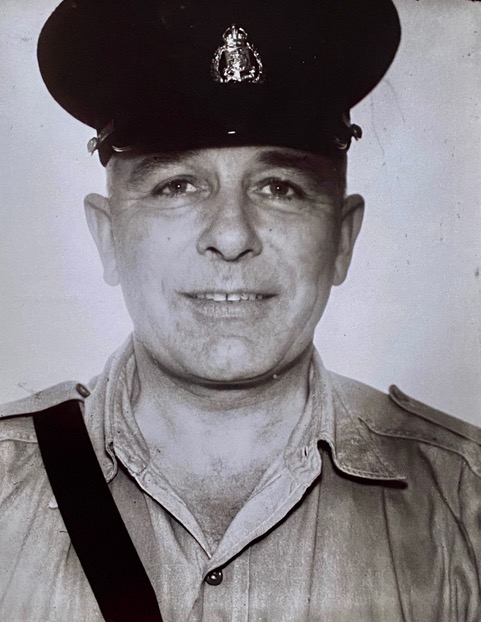
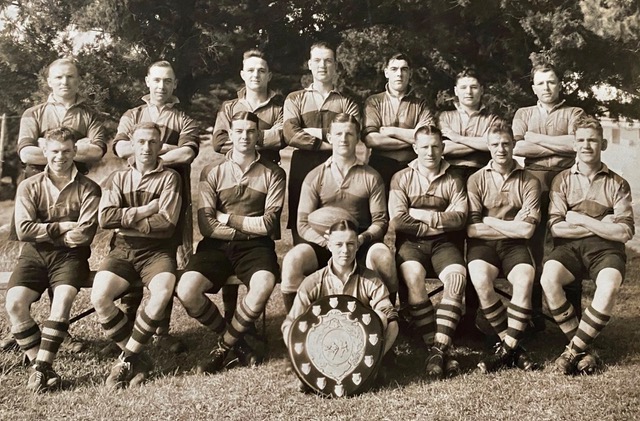
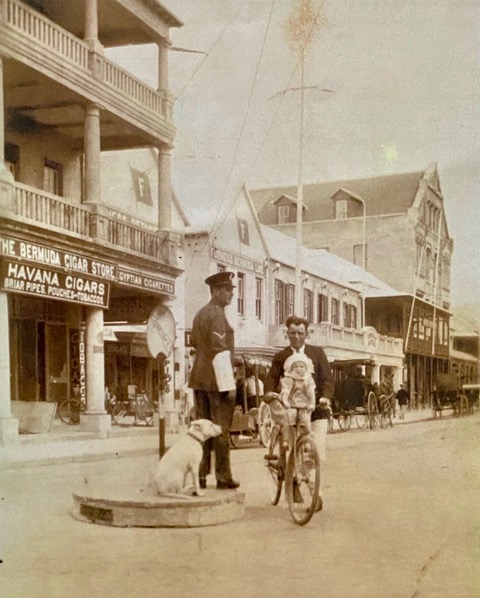
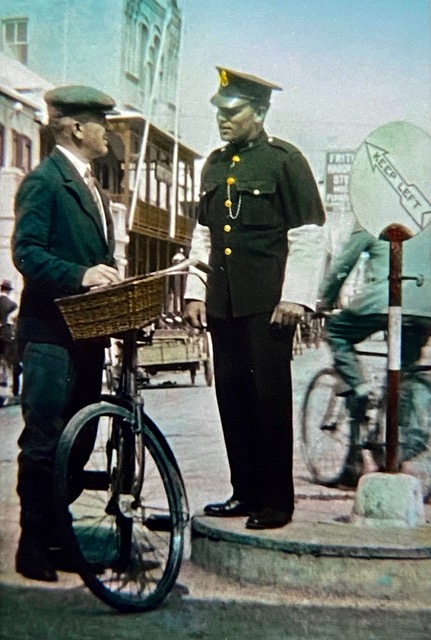
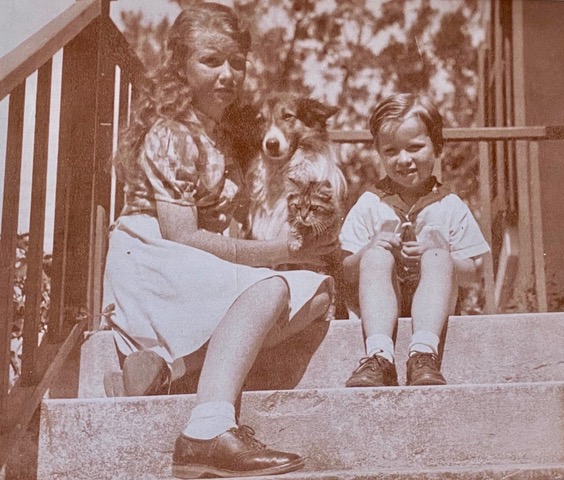
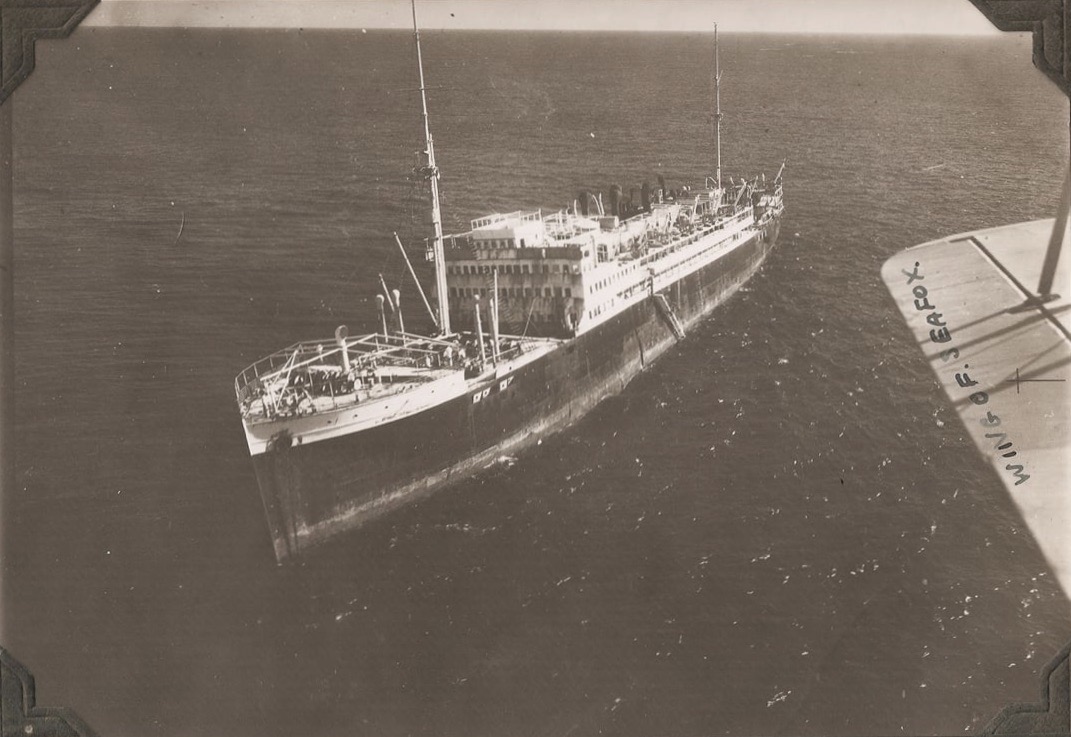 "Cristóbal Colón" breaking up off Bermuda - 1936
"Cristóbal Colón" breaking up off Bermuda - 1936 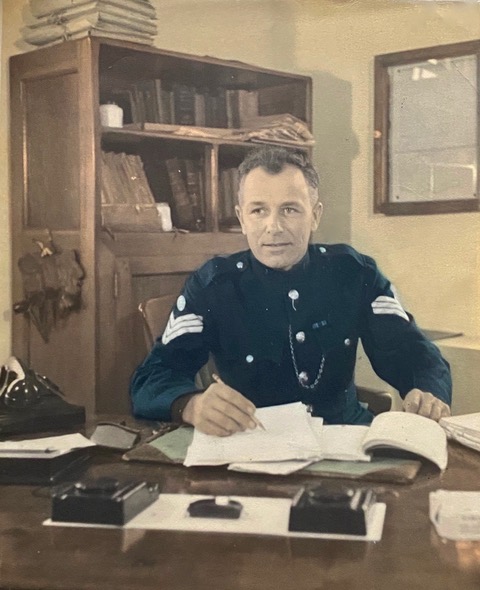
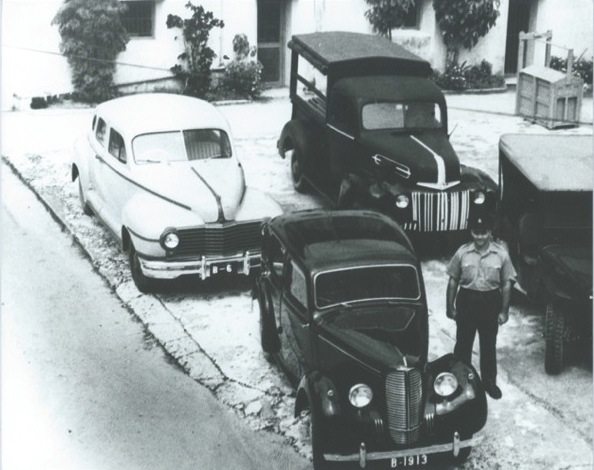 Early Police "Fleet" at rear of Hamilton Police Station
Early Police "Fleet" at rear of Hamilton Police Station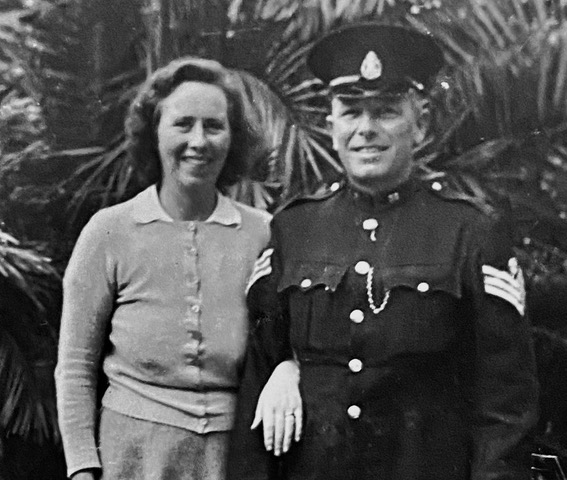
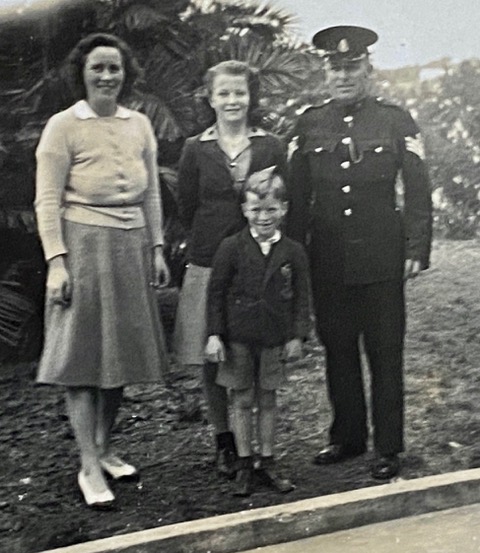
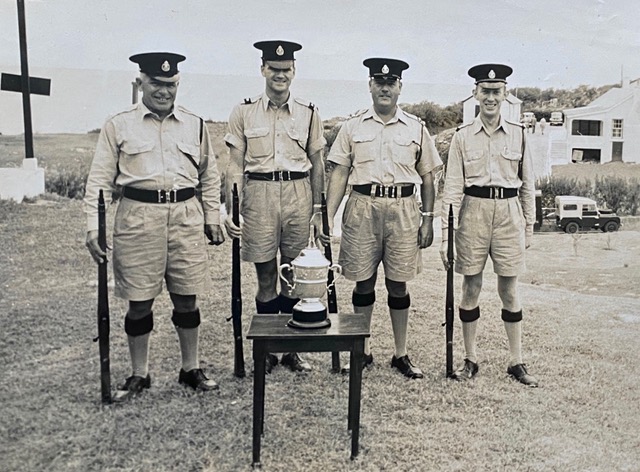 WINNING TEAM
WINNING TEAM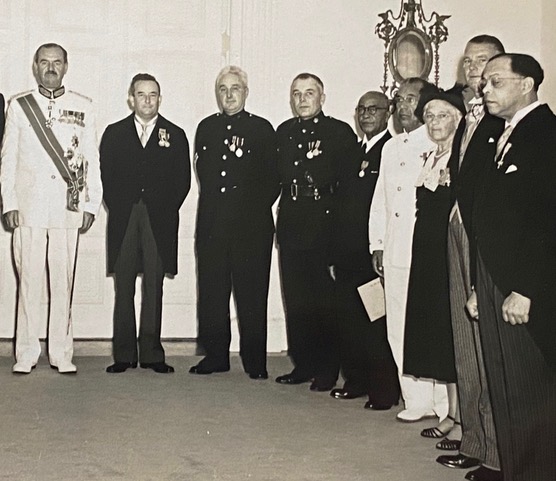
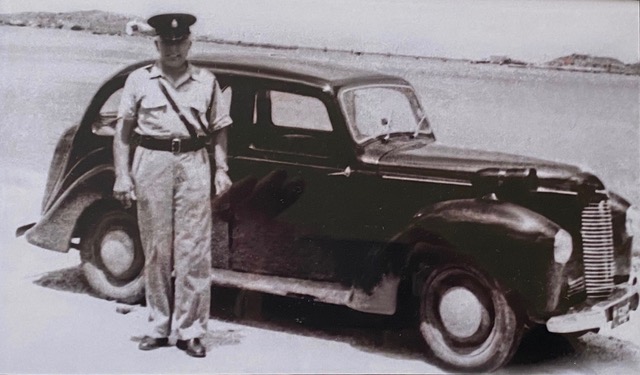
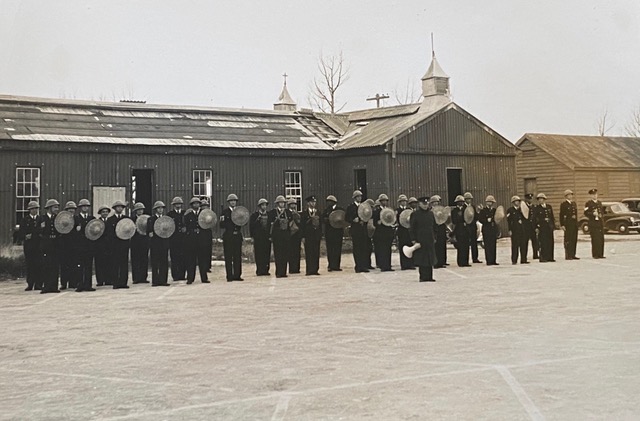
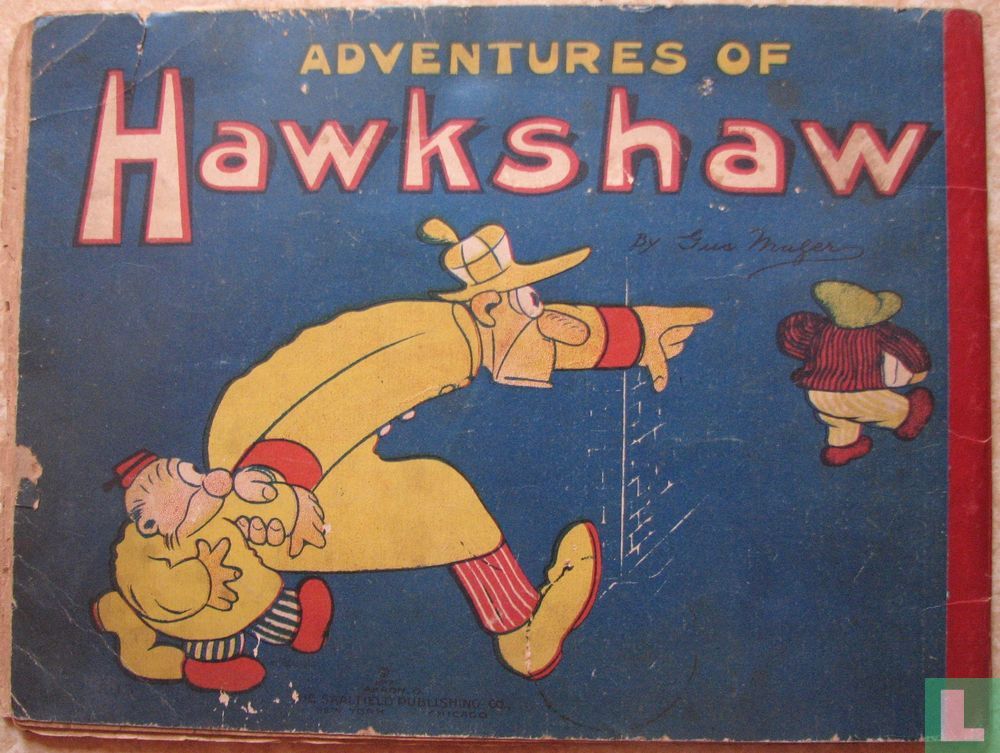
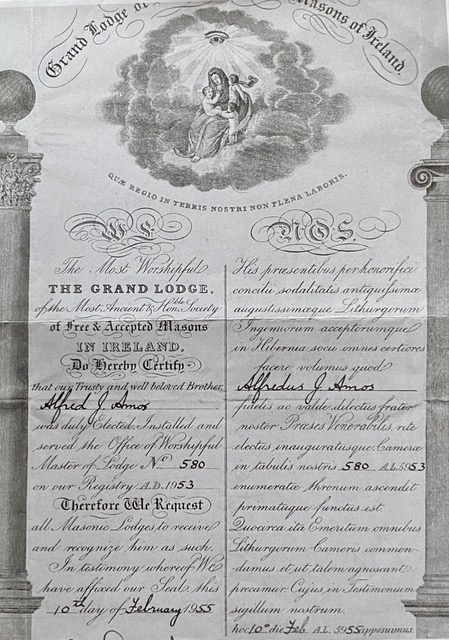
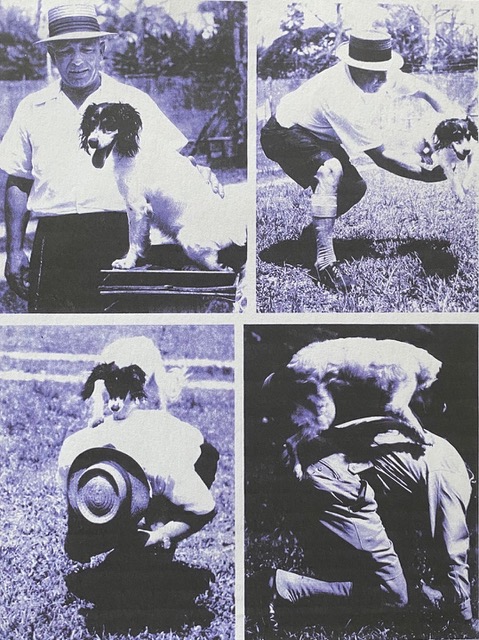 Jim Amos with his amazing performing dog "Sparsa"
Jim Amos with his amazing performing dog "Sparsa" 